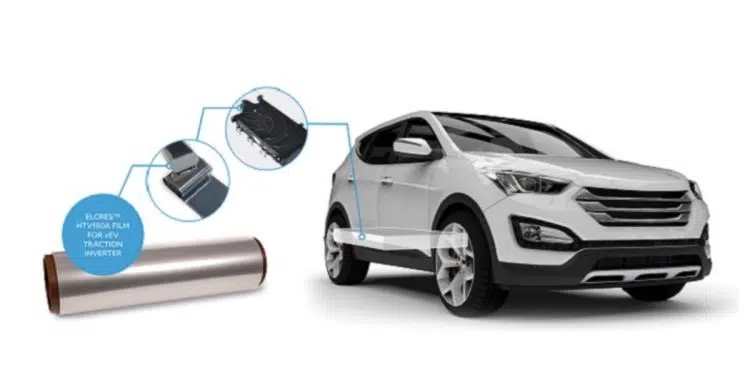SABIC, a global leader in the chemical industry, will introduce at the PCIM Asia Conference 2022 a thinner gauge of its ELCRES™ HTV150A dielectric film.
This new product can be used for capacitors in the traction inverters, onboard chargers and electrical compressors of hybrid, plug-in hybrid and battery electric vehicles (xEV).
The 3-micron (µm) film is 40 percent thinner than SABIC’s previously announced 5 µm film, enabling further volume and weight reductions and greater design flexibility through enhanced energy density for the capacitor.
Like the 5 µm ELCRES HTV150A film, this exceptionally thin film maintains stable performance at high operating temperatures up to 150°C and addresses the critical performance gap experienced by traditional polypropylene (PP) films above 135°C. This new level of thermal performance helps customers increase the adoption of SiC power modules, improving inverter efficiency. A smaller package size with a thinner gauge film reduces weight while providing improved performance such as range and acceleration desired by xEV consumers.
SABIC will conduct an oral presentation at the PCIM Asia Conference 2022 titled, “Reliability Evaluation of New Generation High Temperature Capacitor Films for Inverter Applications,” which is part of the Packaging and Reliability session. Yuan Zhou, lead scientist, Technology & Innovation, SABIC, China, will present on Wednesday, Oct. 26 at 12: 20 pm in conference room 2F201.
“When we launched the five-micron ELCRES HTV150A film last year, we committed to develop thinner gauges to meet requirements for different capacitor voltages – and we’ve delivered on that pledge,” said Greg Stoddard, technical director, Resins and New Chemistries, SABIC. “Our new three-micron film can help customers design smaller package sizes that potentially avoid the use of active cooling systems associated with films that perform at lower temperatures. As OEMs design electric and hybrid vehicles to operate at specific voltages, the new three-micron film can help with differentiation by providing tailored properties. Segmentation of voltage performance aids automakers to match capacitor performance to the needs of different vehicles in their product lines.”
HIGHER TEMPERATURES, THINNER GAUGES
ELCRES HTV150A dielectric film is the first capacitor film in the industry to be engineered for stable performance at operating temperatures of -40°C to 150°C and frequencies up to 100 kHz, while offering stable capacitance, high insulation resistance and good dielectric performance (dielectric constant (Dk) of 2.9, dissipation factor (Df) of 0.0017). Other key properties include high breakdown strength over the full temperature range, good self-healing and excellent adhesion to aluminum and zinc. The film has been validated by customers for use with both film-foil and metalized electrodes. Capacitors built with 3 µm and 5 µm metalized films pass standard electrical and life tests at 150°C for 2,000 hours with low capacitance change and stable insulation resistance. Additional key features and benefits, typical properties and potential applications for SABIC’s ELCRES HTV150A film portfolio can be found in SABIC’s new brochure.
SABIC will continue to develop new products to meet higher dielectric and thermal performance requirements as inverter technology advances, demonstrating its strong commitment to deliver innovative material and film technologies to the power electronics industry.
The PCIM Asia Conference 2022 will be held on Oct. 26-27 at the Chuangjing Technology Center in Shanghai, China.































